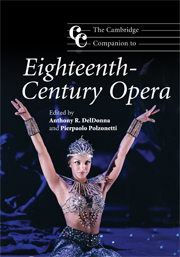Book contents
- Frontmatter
- Part I The making of opera
- 1 Opera as process
- 2 Aria as drama
- 3 Ensembles and finales
- 4 Metastasio: the dramaturgy of eighteenth-century heroic opera
- 5 Roles and acting
- 6 Ballet
- 7 Orchestra and voice in eighteenth-century Italian opera
- 8 To look again (at Don Giovanni)
- Part II National styles and genres
- Notes
- Bibliography
- Index
3 - Ensembles and finales
from Part I - The making of opera
Published online by Cambridge University Press: 28 September 2011
- Frontmatter
- Part I The making of opera
- 1 Opera as process
- 2 Aria as drama
- 3 Ensembles and finales
- 4 Metastasio: the dramaturgy of eighteenth-century heroic opera
- 5 Roles and acting
- 6 Ballet
- 7 Orchestra and voice in eighteenth-century Italian opera
- 8 To look again (at Don Giovanni)
- Part II National styles and genres
- Notes
- Bibliography
- Index
Summary
Ensembles and finales are synonymous with opera buffa. In heroic opera, which focuses on single characters and confrontations between individuals in alternating arias and recitatives, duets and choruses are limited. In contrast, opera buffa specializes in character interactions through ensembles. In these extended, often sectionalized movements featuring multiple characters, the dramatic action switches its focus from the individual to the relational, that is, to the interactions between different groups of characters and the varying and changing dynamics of their interpersonal or professional relationships within the larger community. While furthering the goals of the medium to offer pleasing theatrical entertainment through music, ensembles and finales also typically increase the pace of the dramatic action. They introduce a series of sociable and often-times comedic situations – events, conditions and environments that throw into dramatic relief the many complexities between different members of society, and the methods employed by individuals and groups when negotiating within and between various classes, genders, ethnicities, and age groups. In a medium where communication, interaction, and group dynamics are paramount, a continuous musical backdrop over which naturalistic conversations are conducted openly between a mixed company of aristocrats, servants, professionals or other character configurations, perhaps even with some participants in disguise, works to compound and intensify the potential for instruction in manners, morals, conversational strategies, and social mobility. Various permutations of contemporary societal relationships were enacted on stage. Here, the dynamics of home, family, friendship, the workplace, and other relational communities were played out and “performed” (self-consciously or not) before an opera-going public.
- Type
- Chapter
- Information
- The Cambridge Companion to Eighteenth-Century Opera , pp. 50 - 65Publisher: Cambridge University PressPrint publication year: 2009

